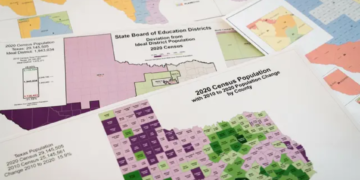Dec 29, 2024 Story by: Editor
New population estimates from the Census Bureau reveal a transformative decade ahead for congressional representation, with the 2030 census likely to reshape the House of Representatives.
According to projections by the Brennan Center, if recent population trends persist, the South is poised to gain nine seats after the next reapportionment — marking the largest single-decade increase in the region’s history.
Florida and Texas are expected to see substantial gains, with both states projected to add four seats each. Texas may even be on track for a fifth. North Carolina would also gain one additional seat, further strengthening the South’s influence in the House.
This surge in representation is driven largely by communities of color. Between 2022 and 2023, over 84% of the South’s population growth came from increases in Black, Latino, and Asian populations, with Latinos accounting for more than half of the total growth. Notably, Florida, Georgia, North Carolina, and Texas were home to the majority of this demographic expansion.
Declines in California and New York
While the South experiences growth, states like California and New York are set to lose representation due to ongoing population declines. California is projected to lose four districts, marking only the second time in its history it has seen a decrease in congressional seats. Similarly, New York is expected to lose two seats.
Other states, including Illinois, Minnesota, Oregon, Pennsylvania, Rhode Island, and Wisconsin, could each see a one-seat decrease based on current estimates.
Should these projections hold, the South would secure a record-breaking 164 seats in the House, a dramatic shift from the balanced representation shared by the South, Midwest, and Northeast after the 1960 reapportionment. By the next decade, nearly 40% of House members could be from southern states.
Electoral College Implications
These demographic and congressional changes would significantly impact the Electoral College. For example, in 2024, Democratic presidential nominee Kamala Harris could win the Electoral College by carrying the states she won, Nebraska’s 2nd Congressional District, and the Blue Wall battleground states of Michigan, Pennsylvania, and Wisconsin.
However, by 2032, this strategy might no longer suffice. The shift in electoral votes to the South would mean that even if a Democrat won the Blue Wall states alongside Arizona and Nevada, they would only secure a narrow 276–262 victory.
Factors That Could Alter Projections
These estimates, while striking, are not definitive. Several factors could influence the final outcome:
- Immigration Policies: A new Trump administration could enact stricter immigration measures, including mass deportations or reductions in foreign student visas and legal immigration pathways. Such actions could affect population growth in immigrant-heavy states across party lines.
- Migration Trends: Recent census data hints at a potential slowing or reversal of outmigration from states like California and New York. If this trend continues, these states may lose fewer seats than projected.
- Census Accuracy: An accurate count is critical. During the 2020 census, states like California and New York invested heavily in outreach efforts, minimizing projected seat losses. In contrast, states like Texas underfunded such efforts and gained fewer seats than expected.
- Controversial Census Questions: A potential push by a Trump administration to include a citizenship question on the census could deter participation in states with large immigrant populations. While courts blocked a similar effort last decade due to procedural violations, a more organized attempt could alter participation rates.
A Historic Shift
Despite potential variables, the overarching trend is clear: the 2030 census will usher in some of the most significant shifts in political power in U.S. history. With five years remaining until the next census, the nation stands on the brink of a pivotal transformation. Source: Brennan Center

















